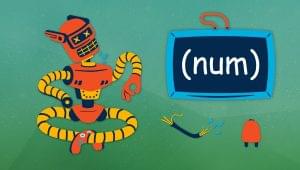Choosing which language to start coding in is probably one of the hardest things about getting into coding. There are just too many options!
You can read this guide on which programming language to learn first. But if you’re stuck between either JavaScript or Python, we’ll be looking at how they compare for learning in this article.
According to the 2023 Stack Overflow survey, JavaScript was the most popular language, with 63.61% of all coders using it, and Python close behind with 49.28% of all coders using it. For professional developers, JavaScript was still the most popular. You can read more about the survey here.
This article will introduce Python and JavaScript, compare them side by side, provide some examples of the syntax of each, and suggest which you should learn.
Overview of Python and JavaScript
JavaScript is a high-level programming language that is usually interpreted. It was created in 1995 by Brendan Eich, and has since become the most popular programming language in the Computer Science industry. It’s used most often for client-side programs for web pages.
Typically, you’ll see JavaScript as a part of the Web Technologies triad of HTML, CSS and JavaScript. These three technologies form the basis of the vast majority of all web pages available on the Internet, with JavaScript enabling the interactivity of a web page.
Python is also a high-level programming language that can be both compiled and interpreted, and was created in 1991 by Guido van Rossum. It isn’t actually named after the breed of snake, but instead the old BBC comedy sketch show, Monty Python’s Flying Circus. According to the Python FAQs, Guido van Rossum was reading the published scripts of Monty Python, alongside developing the language and thought the name “Python” sounded “short, unique and slightly mysterious”, and he therefore decided to use it.
Since its launch in 1991, Python has become one of the most used programming languages, and is typically the language students are taught first in school/education.
Unlike JavaScript, which is typically used alongside HTML and CSS, Python stands alone as a language. Over the years, Python has gained a lot of traction in very technical areas of Computer Science, such as Machine Learning, AI, and Data Science.
A Side-by-side Comparison
With both languages being so popular, it’s very difficult to choose which one to learn first. Therefore, we’ll compare the more fine-grained elements of each language and provide some analysis on which language — JavaScript or Python — fares better.
The topics we will be comparing are:
- ease of Learning
- application
- external tools (libraries and frameworks)
- paradigms
- syntax
Ease of learning
Naturally, the most important thing to consider when deciding between either language is how easy the language is to learn. We can decide how easy a language is to learn through the complexity of its syntax, the amount of resources available, and the size of online communities.
Python has a syntax that is incredibly similar to the English language. Python provides a lot of logical operations as words in the English language (such as not, and, or), making it a very intuitive language to learn, and thus a lot easier to pick up.
For example, if you were searching for an element using a flag found, you would be able to write a conditional statement, such as, if not found.
Furthermore, Python manages the layout of code through indentations and colons (prior to any indentation). This makes Python code very clean to read.
While JavaScript also has a syntax similar to English, it requires the use of symbols in place of words much more. For example, instead of and, or, not, in JavaScript we have &&, || and !. JavaScript also relies on braces and semicolons to separate lines of code.
Having so many symbols can make JavaScript harder to read, and therefore harder to learn, particularly if you have no prior programming experience.
Since Python and JavaScript are so popular, there are a huge array of articles, tutorials, and books available to aid learning either language, such as those available on SitePoint. With so many, it’s hard to decide whether there are more resources for Python or JavaScript.
In addition to online resources and books, the coding community is renowned for its massive online presence across a multitude of platforms, such as Stack Overflow and Twitter. As the most popular language, it’s natural that JavaScript should have the largest online presence.
In summary, Python is the easiest to learn from a syntax point of view, but more wide-spread help is available for JavaScript.
Application
Both Python and JavaScript are considered to be “facilitating languages”, meaning that knowing either (and certainly both!) make programming at a higher level much easier.
Most software developer/coding jobs will require you to have either Python or JavaScript or both under your belt. Furthermore, one of the most popular subsections of software development, web development, centers around JavaScript.
According to the 2023 Stack Overflow developer survey, 65.82% of all professional developers use JavaScript, making it the most common language amongst professionals.
Furthermore, JavaScript is often quoted as the language most in demand from employers. With over 60,000 JavaScript UK jobs appearing from a LinkedIn search, and the average salary of a JavaScript developer in the US being $108,981 (according to Indeed), we can see how in demand JavaScript is as a language.
However, JavaScript is typically only used for web development. Even though JavaScript can be used for other applications, the majority of JavaScript resources center around building web applications (of varying complexity), and so it may be quite difficult to find help developing anything else (particularly if it’s complicated).
On the other hand, Python does not really suffer with this drawback, as it isn’t associated with one aspect of Computer Science. Python can be applied to many fields of Computer Science, such as Machine Learning, Artificial Intelligence, Mathematical Modeling, and more.
Therefore, from a tech career perspective, learning JavaScript would open many doors for you. However, if you’re looking to use programming to facilitate your learning of Computer Science as a whole, Python would be more suited.
External tools (libraries and frameworks)
After learning the basics of Python and JavaScript, the next essential step in your programming journey will be utilizing the vast array of external tools, to help take your programs to the next step.
Python has a wide range of very powerful libraries. These libraries are essentially what make Python such a powerful and popular language. Some of the most popular libraries include NumPy, scikit-learn and Flask.
NumPy itself brings a huge amount of power to Python, with built-in functions that can quickly deal with highly complex mathematical scenarios. Furthermore, NumPy facilitates large-scale mathematical processing and modeling that make Python ideal for research and education. Scikit-learn enables Machine Learning in Python, a very powerful tool. Finally, Flask allows us to create a backend for web pages in Python.
The development of JavaScript tool Node.js was a game-changer for JavaScript, as it simultaneously allowed JavaScript to be used without a browser and for server-side code to be written in JavaScript.
This meant that external tools could be written that didn’t involve web development directly, leading to more packages published on npm than any other language. In September 2022, over 2.1 million packages were listed on the npm registry. At the time, this made npm the biggest single language (JavaScript) code repository. A year and a half on, JavaScript still leads the way in terms of number of external packages available.
There are many JavaScript frameworks, and two of the most popular are React and Vue. These frameworks serve the general purpose of making web development easier and better.
For example, React and Vue deal with state-management to handle data, which makes it much easier to develop large and multi-layered programs, with vast amounts of data required.
Whilst Python has a large number of external tools, JavaScript has many more. Therefore, in JavaScript you can almost guarantee you’ll be able to find a library or framework for what you need, whereas in Python you may struggle in more niche areas.
Paradigms
A paradigm is a style of programming. There are so many different programming paradigms, with some much more niche than others. For example, imperative (procedural), functional, logic, object-oriented, data-oriented, scripting, assembly, concurrent, list-based, fourth-generation, visual, and so on.
Being able to code using different paradigms is a very popular skill as it can introduce many benefits to your code, such as improving the maintainability of code and reusability of certain elements of code. And so it’s likely to become a part of your programming journey.
Both Python and JavaScript are multi-paradigm languages, which means you aren’t limited to always writing programs in the same style. They both support imperative, object-oriented, functional, and scripting paradigms.
If you’ve never met the different programming paradigms before, here’s a quick summary:
- Imperative: code is written as a series of instructions that are executed as they appear in the code. This is the paradigm most programmers begin learning, as it’s viewed as the “most intuitive” and closest to almost telling the computer exactly what you want to happen (in the form of a series of instructions). You can read more here.
- Object-oriented: code is written as a collection of “objects”. Each “object” uses properties and attributes to describe the item we are trying to replicate in the code. For example, in an animal game we might have the class
Dog. A property can be viewed as an attribute that describe the class, such asname = Roverfor theDogclass. A method is a means to update or access the properties. You can read more here. - Functional: code is written as a series of mathematical functions that are chained together to execute the program. For example, if we wanted to add two numbers, we would have to define a function
addthat returnsx + y, wherexandyare the inputs into the function. You can read more here. - Scripting: code is designed to automate tasks or customize existing programs. This paradigm is less popular than the others listed, but essential to JavaScript. You can read more here.
Imperative programming in either Python or JavaScript is very similar, but they differ much more on the other paradigms.
Python has a very neat syntax for object-oriented programming (OOP), using classes to define objects with properties and methods (as functions/procedures). This syntax follows very closely to the formal definition of an object in programming. This is due to the fact that, in Python, almost everything is an object (even if we don’t notice it).
On the other hand, JavaScript’s syntax for object-oriented programming is much less neat, and much less intuitive than Python. However, JavaScript is very famous for its use of the document object model, that makes event-based programming very natural and much easier than in Python.
Event-based programming is essential when making web applications, as we want to be able to give our websites some interactivity. Therefore, JavaScript is a much better language for the scripting paradigm (as the name would suggest!).
Whilst functional programming can be achieved in both languages, JavaScript’s introduction of the const keyword and arrow functions in the ES6 update has made functional programming in JavaScript much easier.
It’s important to bear in mind that, when learning both object-oriented and functional programming, it would be better to use languages dedicated solely to these paradigms. For example, Java or C# for OOP and Haskell or Elm for functional.
Therefore, for early learning and experimenting with OOP or functional programming, Python and JavaScript will work perfectly. And if you’re keen to learn the scripting paradigm, JavaScript would suit much more.
Paradigm summary
| Topic | Python | JavaScript |
|---|---|---|
| Syntax | Win: the similarity to English makes it very easy to learn | Loss: the use of symbols makes it quite hard to learn |
| Online resources | Tie | Tie |
| Online community | Loss: Python isn’t quite as popular | Win: JavaScript is the most popular |
| Job opportunities | Loss: as not as many jobs will require Python | Win: as web development is a huge sector, that almost primarily asks for JavaScript |
| Wider Computer Science use | Win: Python can be used for Machine Learning, AI, Data Science, Mathematical Modelling etc. | Loss: JavaScript mostly known for website development |
| Number of external tools | Loss | Win |
| Effectiveness of external tools | Tie | Tie |
| Imperative programming | Tie | Tie |
| Object-Oriented | Win: as syntax of class definitions is very similar to the formal and theoretical definitions | Loss: the syntax of class definitions is too far from the formal definitions |
| Functional programming | Loss: possible in Python but harder to maintain the rules of functional programming with Python’s syntax | Win: use of const and arrow functions help greatly |
| Scripting | Loss: possible, but without the document object model it becomes very tricky | Win: the use of the document object model makes event handling much simpler |
Syntax
Although we’ve already discussed the syntax of both languages, we’re going to take a more in-depth look at the more subtle differences of both. We’ll look at the most standard programming instructions and how Python and JavaScript differ.
Printing
An essential notion in any programming language is printing. In any good beginner’s programming tutorial, the first program you write should print the phrase Hello, World!.
Here is how this is done in Python:
print("Hello, World!")
<< Hello, World!
And in JavaScript:
console.log("Hello, World!")
<< "Hello, World!"
As you can see, these are very similar. But already, we can see the closeness of Python to the English language, whereas JavaScript has a much more technical feel.
Variables
Another essential notion in programming is being able to use variables. Variables are essentially a means of storing the data we need to use repeatedly in our program.
Python and JavaScript are pretty different on this front.
For example, in Python we only need to give the name of the variable and an initial value:
best_number = 29
print(best_number)
<< 29
Whereas in JavaScript, any variable must be declared with one of three keywords — var, let, or const (although const can only be used when the value of the variable won’t be reassigned, remaining constant throughout the program):
var bestNumber = 29
let secondBestNumber = 20
const worstNumber = 27
console.log(bestNumber, secondBestNumber, worstNumber)
<< 29 20 27
However, the use of var is pretty outdated by modern JavaScript standards, so it’s best to avoid it and use let for any variable that requires changing.
if statements
An if statement is a way to create a branch in a program based on a condition. In English, we can think of it as: “if this is true, run this code. Otherwise, run this code”. For JavaScript and Python, this is very similar. But this is where we start to see the impact of JavaScript’s brackets and braces that we discussed before.
In Python, we would write:
if best_number == 29:
print("That's correct! That is the best number")
else:
print("That's wrong...the best number is 29")
Notice that we have to use == to test if two values are equal to each other. Additionally, notice the colons at the end of each part of the if statement.
We can add more branches to the if statement, with the keyword elif, which stands for else if.
For example:
if best_number == 29:
print("That's correct! That is the best number")
elif best_number == 20:
print("Close...that's the second best number!")
else:
print("That's wrong...the best number is 29")
In JavaScript, we write:
if(bestNumber === 29){
console.log("That's correct! That is the best number")
}
else if(bestNumber === 20){
console.log("Close...that's the second best number!")
}
else{
console.log("That's wrong...the best number is 29")
}
As you can see, we use {} braces instead of the colons in Python, and we have to contain the code of the if statement within brackets.
Also, we have to write === in JavaScript instead of ==.
Finally, it’s important to understand that, in JavaScript, we don’t need indentations for the code to run, and we could write the code like this:
if(bestNumber === 29){console.log("That's correct! That is the best number")}
else if(bestNumber === 20){
console.log("Close...that's the second best number!")
}
else{
console.log("That's wrong...the best number is 29")
}
But this looks very messy, and JavaScript is hard enough to read as it is! Therefore, most people try to keep indentations as a part of their code.
for loops
A for loop is an iterative technique in programming that we use when we want to repeat a block of code for a set number of times.
For our example, we want to use a for loop to execute code 29 times (obviously).
Therefore, in Python, we write:
for x in range(0, 29):
print(x)
Here, x is a temporary variable that changes value with each iteration of the for loop: on the first iteration, x = 0, on the second, x = 1, and on the third, x = 2, and so on. Therefore, our program will output 0, then 1, then 2 and so on until 28.
As you can see, the range function is bounded by two limits: 0 and 29 . However, the upper limit, 29, is not inclusive.
JavaScript has exactly the same principle but quite a different syntax:
for( let x = 0; x < 29; x ++){
console.log(x)
}
Breaking this down, we have three components separated by a semicolon:
let x = 0declares the temporary variablexwith an initial value of0. This will have the exact same purpose as thexin our Python program.x < 29means that we only want to keep running thisforloop whilexis strictly less that the length ofmyNumbers. In other words,xwill take the values of0,1,…,28, before we stop executing.x ++is the shorthand way of writing that, with every iteration, we want to increase the value ofxby1.
As you can see, JavaScript has a much more manual setup that requires a lot more symbols. Even though this setup is harder to read, it’s actually very similar to other famous languages, such as Java and C.
Additionally, JavaScript (as mentioned above) relies on the use of different brackets and braces to separate code, whereas Python only relies on indentation and colons.
while loops
while loops are another iterative technique in programming, and work as a sort of mash-up of an if statement and a for loop.
A while loop will execute a block of code until a condition is met.
For example, we want to keep outputting Wrong! until the best_number equals 29.
In Python, we would write:
while best_number != 29:
print("Wrong!")
The != means “not equal to”, where ! means not. Therefore, we run the print statement while the best_number is not equal to 29, meaning that the while loop will run until the best number is 29.
In JavaScript:
while(bestNumber !== 29){
console.log("Wrong!")
}
These are very similar, with only subtle differences such as !== as opposed to !=, and all the difference we discussed above.
Syntax summary
Syntax is all about how the language is written and how it looks to the reader. It’s trivial to see that Python has the much cleaner appearance, to the extent that even someone who had never programmed before could read a simple Python program and understand what it was achieving.
JavaScript, on the other hand, like the majority of programming languages, favors symbols over words. This makes the appearance and layout a bit more mathematical. Perhaps surprisingly, the syntax of JavaScript is actually very similar to other popular languages, such as Java.
Therefore, on the whole, Python is definitely easier to learn than JavaScript if we’re just considering the syntax. However, JavaScript has a much more transferrable syntax, meaning that once you’ve learned JavaScript, learning another language like Java or C will be a lot easier.
Conclusion
Now that we’ve had an overview of Python and JavaScript, it’s important to remember that learning either won’t do you any harm! Any coding is better than no coding!
However, from a more technical point of view, if you’re looking to learn coding with the intention of finding a software development job or you have experience with another language, JavaScript is where we recommend you start.
If you’re looking to learn coding simply for the sake of learning, we recommend Python, as it provides a bit of an easier transition into the coding world.
Olivia Gibson is a student of Maths and Computer Science. Over the past year, she has immersed herself in the world of web development and loves coding in JavaScript and Python. Some of her highlights include, Numble and German Flashcards.
Darren loves building web apps and coding in JavaScript, Haskell and Ruby. He is the author of Learn to Code using JavaScript, JavaScript: Novice to Ninja and Jump Start Sinatra.He is also the creator of Nanny State, a tiny alternative to React. He can be found on Twitter @daz4126.








